by Beth
Cool weather from week 7 continued into this week. April has been good for hardening off chicks in wind and rain. It’s been less good for moving them to the coop full time, though they could’ve moved outside this week except for 2 last issues.
Issue #1, that the chicks are sleeping on the ground instead of up in the coop, called for trickin’ chickens with mealworms and flashlights. Issue #2, severe weather, spiraled us into serious homestead-planning mode and changed the way we’ll keep chickens out here.
I’ve gone chicken crazy, and this sweet chicken tractor is about to get a big friend.

Day 50
Last week, I wouldn’t have put the chicks outside on a day this cold, but with their latest extra feathers and body weight, they frolicked in the low 40s like it was no big deal.
When I sat with them to make sure everybirdy was okay, Cogburn caught a nap in my lap. I think he’ll grow out of this. In fact, he should start testing us more soon.

A good rooster is your partner in keeping the flock safe, but apparently the transition from baby bird to protective working bird can be rocky. Hopefully all the bonding now will make it easier to sort things out when he goes into teenager mode.
He’s been a leader since day one. Here’s tiny Rooster Cogburn watching over the flock in the brooder.

As chicken keepers, our responsibility is to support him with good predator proofing and by learning to listen for him. Even a large rooster can’t defend against most predators; he’s still just a big chicken. But he can warn us danger is around. It’s one of a few reasons roosters crow. He seems to take his post seriously. He’s always watching and corralling the flock. We think he’ll be a good rooster.

In other news, I finally found a bale of coop bedding to order. Bedding or “litter” goes on the coop floor to draw messes and moisture away from chickens. People use everything from peat moss to wood chips to sand. Some materials are less preferred: apparently cedar and certain types of sand cause respiratory problems, straw promotes mites and mold, hay can clog chickens’ crops. We have part of a bag of pine chips left from the brooder and can use that, but pine chips are DUSTY.
As pricey as it is, I wanted to try hemp. It’s supposed to last much longer than pine and be dust-free and more absorbent. That may all be a gimmick, but I like to support the hemp industry, which is evidently kinder to the world than the logging industry, and hemp purportedly composts better than pine. Compost is a major benefit of having chickens – as we get our gardens going, I’m almost as excited about compost as about future eggs – but pine bedding has questionable effects on compost.
When I went to purchase a bale of hemp, I was again confronted by how hard it has been to find poultry and gardening supplies online since the beginning of March. An order of vegetable seeds was delayed by 3 weeks. Chicken hatchery and mealworm farm websites have homepage messages asking for patience. Our coop guy says he has no idea when he can start the 2nd chicken tractor we ordered. He’s had 3-4x more orders than a normal spring.

This is awesome, by the way! We should all be growing food. It’s been easy enough to avoid inconvenience by planning ahead, but after days of searching online, it started to feel like there was no hemp bedding left in the world. I perused everything from farm- and hemp-supply to big-box-store websites. Every bale from a source I trusted would be gone before I could click through checkout. Yesterday at 6:30 a.m., I just missed a pack of RentACoop hemp. But I checked this morning to see if they added more stock, and boom, got an order in.
Shipping should be at least a week. I won’t believe I snagged a bale until I see it with my own eyes, but we’ll use pine chips if we need bedding before it arrives.
There’s no telling when we’ll need it. Weather this week looks wretched, and I can still barely convince the chicks to walk up to the coop part of the tractor, much less sleep there. They have to learn to sleep protected in the coop before we can leave them out at night.
Day 51
The hemp bedding arrived this afternoon. What!? I carried it to the chicken tractor, and surprise #2, a few chicks were in the coop. I offered them mealworms in there this morning, and now chicks in-the-know run up the ramp when they hear me coming.
It was easy to entice them to leave so I could put bedding down. They love it when the door to the run opens so they can go forage. Here’s a video:
The “hole in the floor” point in the video is why a lot of people prefer the door on the side, not the bottom, of the coop. You can build a lip around the door hole, but it would hang up the coop’s removable/cleanable floor, and bedding can easily fly over a lip. The trajectory of chicken scratch is pretty high.
Chickens aren’t supposed to spend much waking time in the coop, so they may not scratch a ton of bedding out. We’ll go back to the drawing board if they do.
In other news, the sun came out, sending the chicks into dustbathing mode, which they do in a pile. You’d think they’d grow tired of kicking each other, but they don’t.
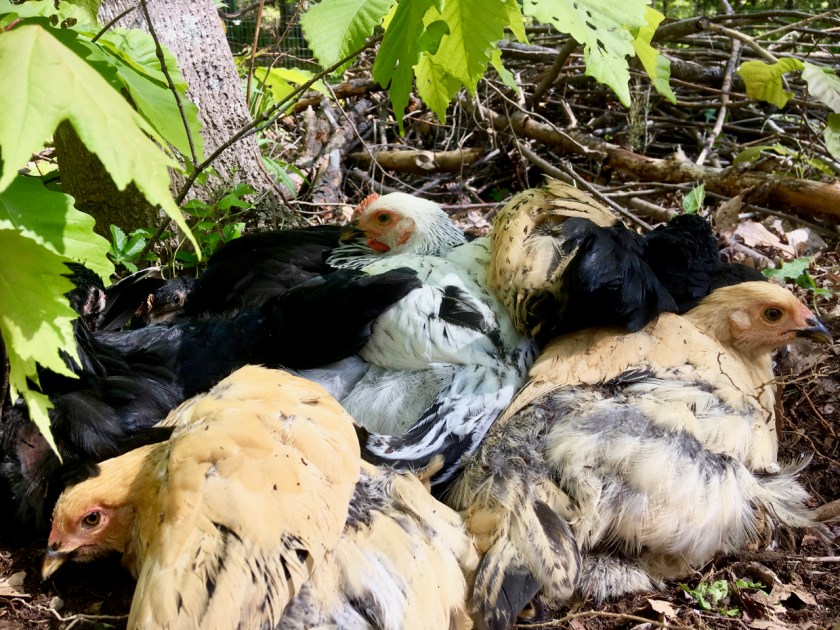
Dustbaths make chickens’ world go round. You can hear their happy purring in this video:
And here’s a video with a cluck, which they surprise themselves with sometimes. Chicks aren’t supposed to start clucking or bok-bokking until after 10 weeks, but these have been letting out deeper noises for a couple weeks.
Later, the hawk came by. It doesn’t care if I wave at it, so I aimed my phone up to flash light, and it soared off.
I looked around. The CDs are supposed to be twinkling to repel hawks, but every CD has been blown down repeatedly in recent storms. I had propped them around the edge of the run on the ground. Time to hang them all back up, this time with a coarse twine that shouldn’t come untied as easily.
There was no loud peeping at sunset, so I took a deep breath and left them out as the sun went down. When I went to check on them after dark, I found a pile of sleeping chicks in the corner of the tractor run. A few cracked an eye at me, but nobody came running for oats. It was probably peaceful falling asleep to their first sunset. I let them be, relieved I haven’t made them afraid of the dark. They protest when I turn off the light by the brooder in the study, but here they were, purring as they fell back asleep in the dark.
Chickens are strongly governed by light and dark. I didn’t want to wake them. However, it’s not safe to let chickens sleep on the ground, and an even bigger issue was that heavy rain and wind were forecast after midnight. At 10:30, I went to the tractor armed with a flashlight, thinking they might run to the light. They did!
At least the Brahmas did. I shone the beam into the crate, opened the tractor door, and the Brahmas ran right in for oats. The Langshans were more groggy and had to be scooped up but didn’t protest.
In the study, they found their roosting spots and crashed. Donna’s roosting spot was my lap. Lap chickens are a treat. I don’t want to discourage the behavior so let her stay there for 10 minutes, then tried for 5 minutes to convince her to take a choice open spot next to Cogburn, but Donna’s nobody’s fool. I eventually picked her up and set her on the bin rim with the others, then turned the light out. Their annoyed cheeping stopped after a moment.
Day 52
It raged last night. The rain stopped by this morning but left cold weather behind. The morning was cloudy in the low 40s. Temperatures eventually crept up to the mid 50s. The chicks were able to go out early and stay out all day with no problem.
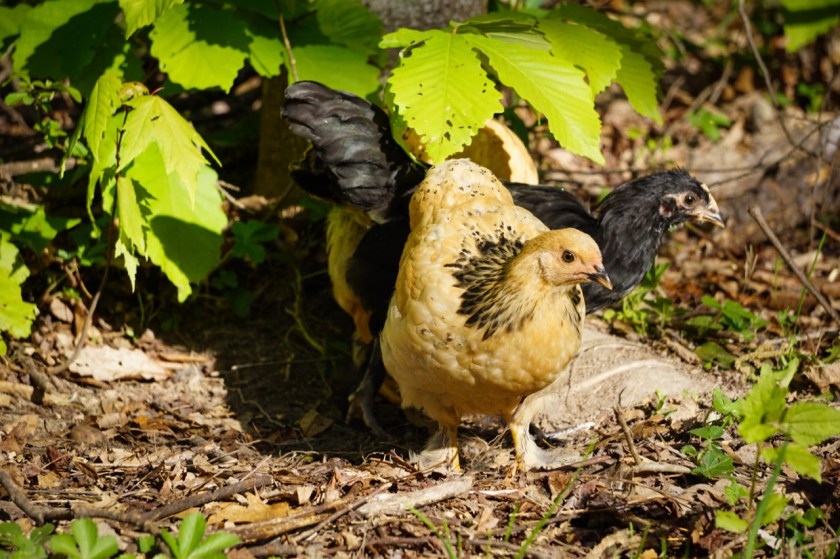
The hawks aren’t flying as low over the run. The CDs may be helping. Either way, this morning I ordered a giant, heavy-duty net to cover most of the run. We’ll use the hawk strings as scaffold.

I went quarantine hiking in the woods and came home after dark, in time to collect drowsy chicks off the ground in the run and bring them out of the cold weather. In the study, they fell asleep roosting on my leg. They love roosting. Not sure why they won’t try the roost bars in the coop.
Day 53
This morning we got a bead on one of the hawks through the binoculars when it landed on a power pole. It’s tiny. We think it’s a broad-winged hawk. They eat mice, frogs, and insects and are less likely to go after our chickens when they’re full grown. That would be great news but doesn’t mean we can stand down against aerial predators. Even small hawks can be opportunistic, and larger hawks cruise the area. Plus we have owls, and a pair of bald eagles soars by once in a blue moon.
In other news, I’ve been researching roosting and noticed an issue with the roost bars in the tractor’s coop: they’re only 6″ away from the wall. Some people say bars that close keep the chickens warmer; others recommend 12-18″ from the wall for a few reasons, including that some chickens don’t like their tails to touch the wall. In fact, ours only roost on the bin in areas with full tail clearance. Cogburn, at 1/4 his eventual size, is irritated when I place him on the tractor’s roost bars, and it might be because his tail rubs the wall.
By instinct, birds roost facing different directions. They’ll be unhappy if the wall is smack in front of their beak or rubbing their tails. These roost bars might work for birds who don’t care or are smaller, but as much trouble as it’s been getting the chicks to roost, we decided to make an adjustment. Chris grabbed a drill, and we moved one bar as far forward as we could based on the space inside the coop.
It was a production. The tractor is well made. Its parts aren’t easy to rearrange. We’ll wait to move the 2nd roost bar until we know if this was a good choice. Between this and the bedding possibly falling out of the floor hole, plus future space concerns for mammoth chickens and eye-opening severe weather this month, we’re having tractor doubts. We may need to change our approach to full-time chicken housing. If so, we need to decide before our coop starts our 2nd chicken tractor.
Day 54
This morning, we locked the chicks in the tractor, switched on the fence, and made a trip to Oak Ridge to tour a Quaker-style chicken coop on our shed guy’s lot.
As we left, a hard wind blew through the orchard. Usually the forest buffers the wind, but this gust came in low. We could see the chicks in the tractor catching the brunt of it, feathers flying up. They didn’t look as concerned as I was. They’re acclimated to breezy conditions; most days this month have had sustained, double-digit winds. Here they are looking like frizzle chickens with the wind blowing their feathers up.

The weather was supposed to turn sunny and warm, so I sucked it up, and off we went.
When we came home, it was unexpectedly, 0%-chance-of-rain raining. Sigh. The chicks were piled in a different corner of the coop. The tractor kept them miraculously dry, but they seemed too excited to see me. Something might’ve blown by and freaked them out. They shook it off and went for the food I poured, but it would really help if they’d shelter in the coop. I have brainstorms.
Another thing that will help: the new coop. After touring a spacious, permanent coop and having a deep conversation about homestead goals, we’ve decided to cancel the order for a 2nd chicken tractor and splurge on a fixed coop with an attached run. This is the model, but of course ours will match the colors of the barn, shed, and chicken tractor.
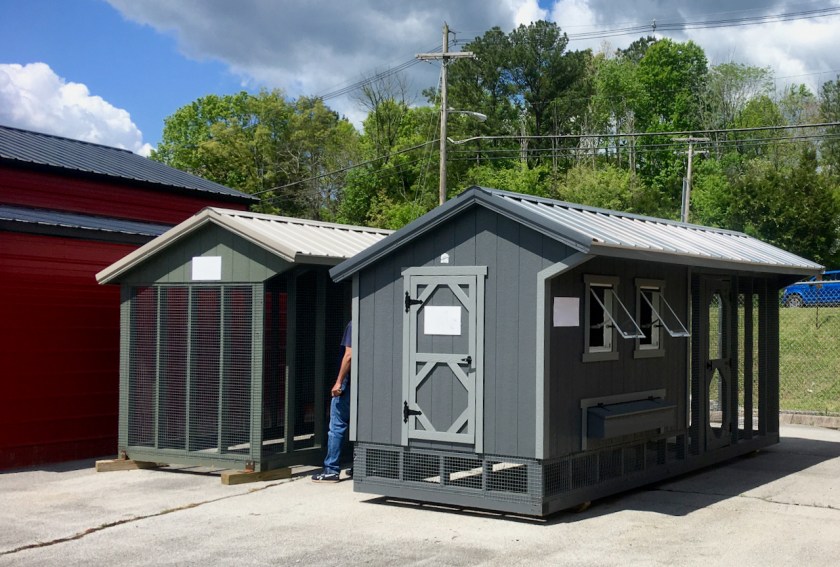
A fixed coop is a commitment of money and space. We had planned to use tractors so we could move the flock(s) with us up the hill to the dome. However, after realizing what a good spot the chicken run is in and working so hard to install predator proofing, we feel differently. A fixed chicken structure will let us breathe easier.
It’s much roomier, providing space for the flock to grow without crowding. When we travel again, one day in the non-socially distanced future, the coop will make chicken care something that a beginner can handle: give food and water, take eggs, lock door, turn on fence. We can also fully close it against this high wind and sideways rain that won’t ever stop.
The attached run adds cost, but the convenience and safety are worth it. A secured, covered run will give growing chicks a larger protected outdoor area to frolic in when we’re not around to supervise them in uncovered areas. These breeds don’t reach full size for about a year, and during that time, they’re extra susceptible to aerial predators.
There’s a reason we’re being obsessive about predators. As far as we know, every neighbor around us with chickens has experienced loss due to predators. The fewer losses we suffer, the more we’ll enjoy this part of the homestead, and the more we’ll be likely to stick with it. Even though we’ve started a flock, we’re still truly in planning mode for the future. Our decisions now will help shape what the homestead looks like for years to come.
Day 55
The permanent chicken coop is a big investment in money and space, so we slept on the decision and woke up more excited than ever about a permanent chicken building. I called early to start pinning down order details with our shed guy, like colors, wire gauge, and door placement.
Then I called our coop guy to withdraw the order for a 2nd tractor. I knew he hadn’t begun working on it yet. He’s so swamped by the latest backyard-chicken craze he said he’s now 10 weeks out on orders. The permanent coop won’t arrive for 5 weeks, which is a standard amount of time for a shed build with this group; maybe pandemic buyers haven’t reached this level of commitment yet.
The tractor will be the flock’s house until then, and it’s been a good brooder-transition coop so far. It’s secure, and I love being able to move it to new grass daily. When this flock moves to the big coop, if all goes as planned, it should be almost time for the next round of chicks to move from the brooder out to the tractor, where they’ll live until they’re large enough to safely move in with the older birds.
For now, we need this flock to figure out this coop. I hung a rechargeable camping light to attract the chicks up the ramp to the coop when it’s dark out. They walk up the ramp throughout the day but bobble down at night to sleep on the ground. The damp, chilly ground. When I try to put them on the roost bars, they’re indignant. They’re not big on being picked up right now; it may have something to do with new feathers still growing in.
I don’t want to have to pick them up anyway. They need to learn to hop up. I have one more card to play.
Day 56
8 weeks old! A milestone. Some people stop calling them chicks at 8 weeks. Others wait until 16 weeks. Either way, it feels good to have helped these tiny fluffpants…
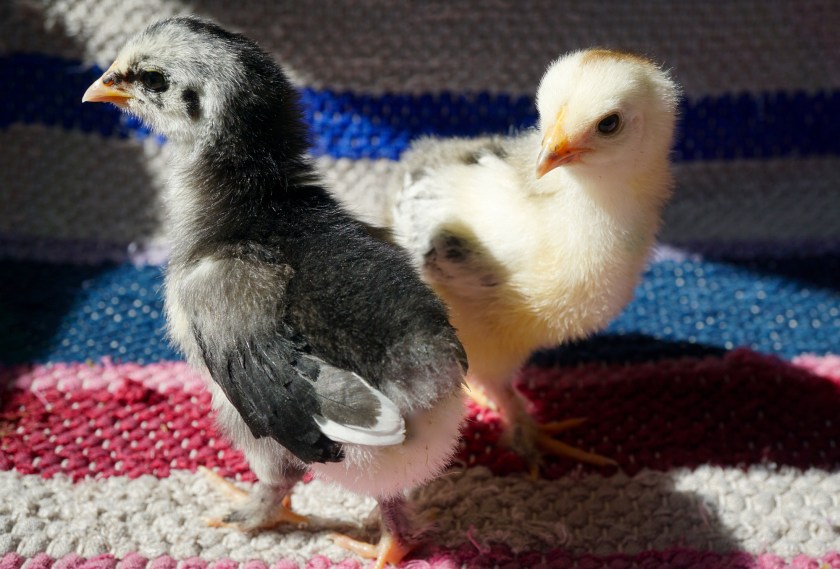
…grow into a calm, curious flock that’s more independent by the day.
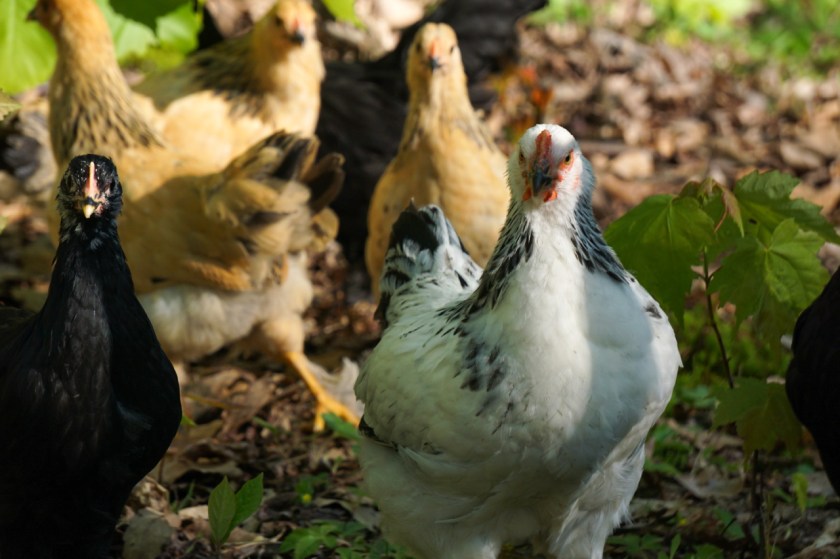
I’ve learned a lot about myself, chickens, and raising animals. One big lesson has been about learning to read the chickens. I do a lot of research to understand chicken basics, but ultimately our birds point us to the easiest solutions, if we have the patience to decipher what they’re telling us.
Convincing them to roost in the coop is an example. A month ago, their wings hit the wall when they tried the roost bars, which made them unhappy. They were just as dissatisfied being placed on the bars because their tails rubbed the wall. Moving a bar out helped to solve both of those issues, but we still had to get them to try flapping up again.
The urge to hop up had to exceed their bad memories. Today I made sure the coop was airy and bright with the light on, then tied oregano on strings above the roost bars, and voila, the chicks are hopping on the bars on their own.

The next step was to get them to try it at night. Before sunset, I flipped the camping light on in the coop. When I went to visit them after dark, instead of opening the door to the run, I opened the coop door and called to them from the top of the ramp. They waddled up to see me (see if I had mealworms). The light and dishes of food and water kept them up there.
All except Popsicle, who didn’t even walk up the ramp. She was out in the run doing that forlorn peeping she used to do when she found herself alone in the brooder bin. It took me back to the first week of raising chicks, when I woke up to peeping at 4 a.m. Tiny Popsicle was lost in the dark on the other side of the bin from her flock.

That night, I held her in my hand for a minute until she was calm. When I put her back in the bin, she disappeared under the heater and was quiet for the rest of the night. She looks different now, but her peeping sounded the same.
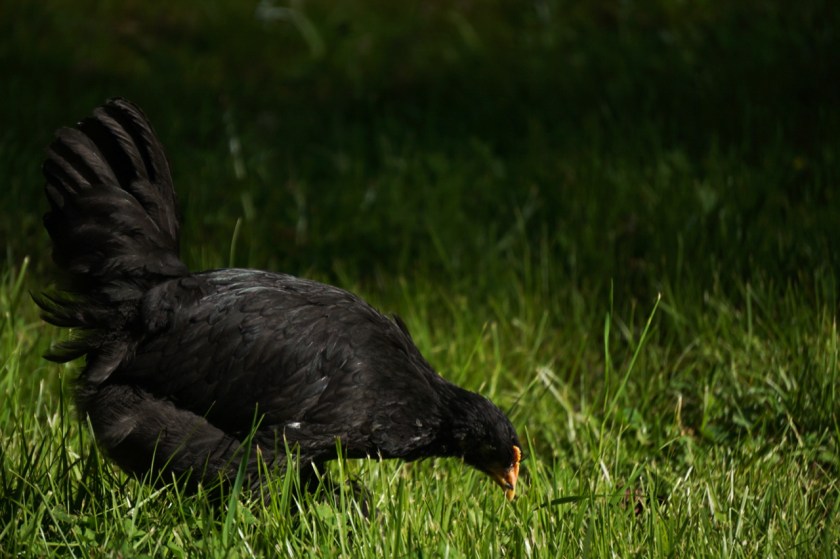
I scooped her up and held her for a minute, then put placated Popsicle in the warmly lit coop with the flock. She ran over to see what everybody else was doing.
The chicks started to hop on the roost bar and preen. All 7 fit on one bar without crowding, which meant no pecking for position, and it will help them stay warm. One by one, their eyes started to close, and they sunk into fat, beak-faced water balloons. It looked like they might be able to stay outside for the night.
My heart. I’ve spent the last 2 months keeping them safe in a world that feels less safe than ever. They’ve looked to me for security and kindness. I’m proud of how healthy and tame they are. Was I really about to leave them in the elements overnight, where I couldn’t hear them peeping if they needed me?

Not yet. I’d avoided the depressing weather radar all day, but another major storm was in fact headed our way. There was a possibility the chicks would freak out in severe weather at 3 a.m. and run out of the coop to get soaked and chilled. At 11, I went to see if I could coax them off the roost bar into the chick chariot.
They ran down the ramp and into the crate without hesitation. In the study, they fell asleep right away. In the morning, they’ll run into the crate as soon as they see me, ready to go back outside. We’ll keep up this routine until we know they’re okay out there. Week 9 is looking good for it, but if this spring has taught everybody anything, it’s patience.


Love reading about the Chicks! I think your attention to them will really pay off. Sounds as though they trust you.
LikeLike
If my chicks have a comb on thier head, does that mean its 100% a rooster?
LikeLike
Actually pullets have combs, too. Some breeds just have much bigger combs as chicks. If a chick’s comb is red by 4-6 weeks, it’s more likely to be a boy, but there are a lot of other signs. A good way to get advice is to post pictures on backyardchickens.com or other chicken-based social media pages–there’s an “Easter Egger Chicken Gender Gurus” Facebook page that is excellent.
LikeLike